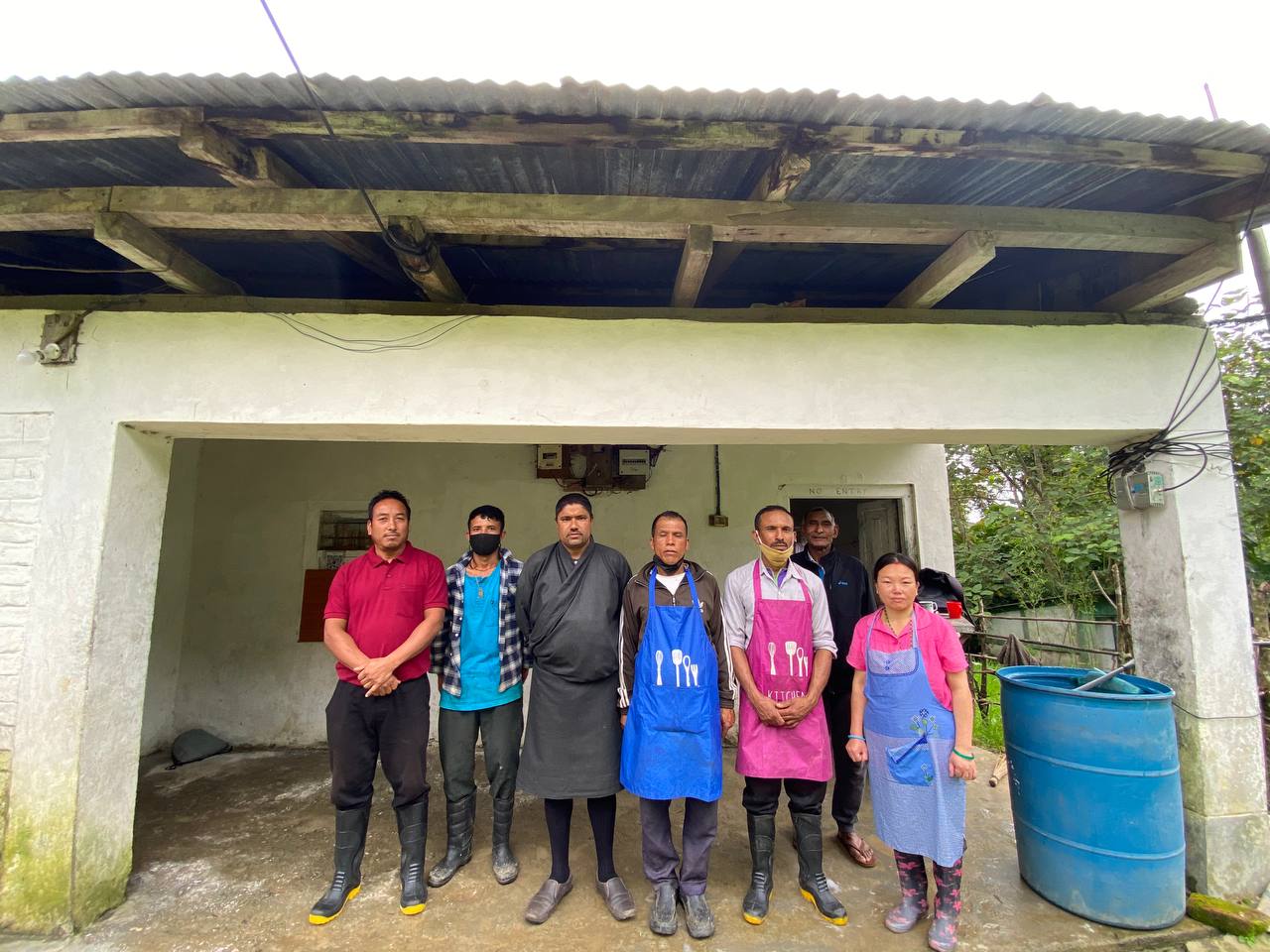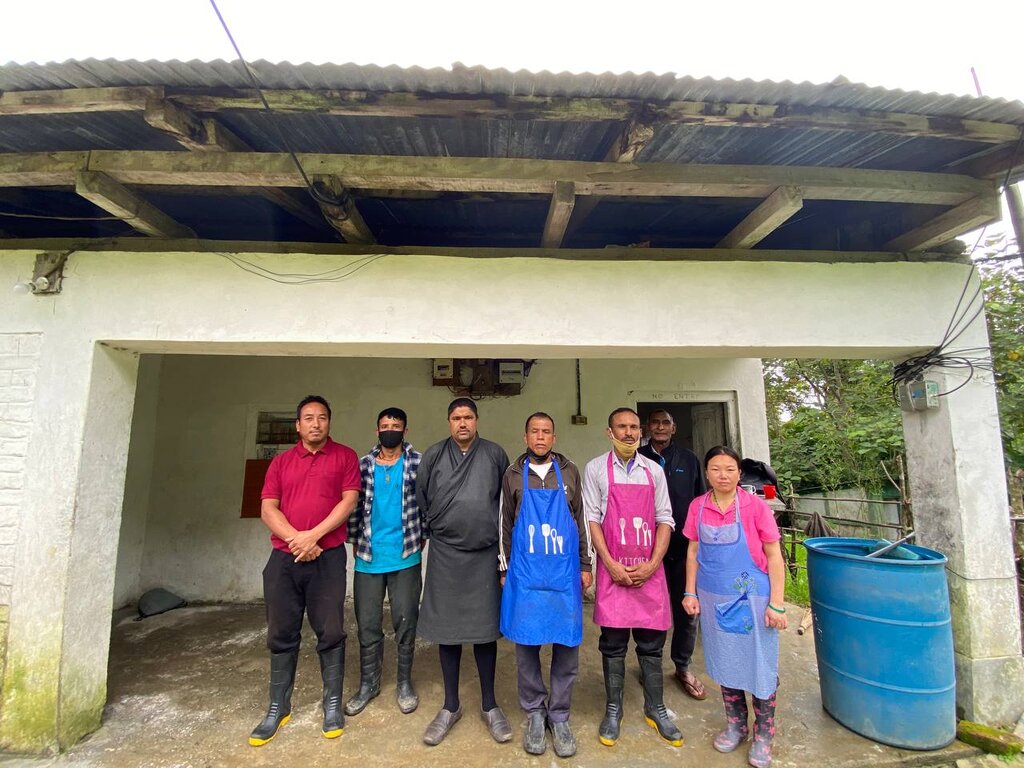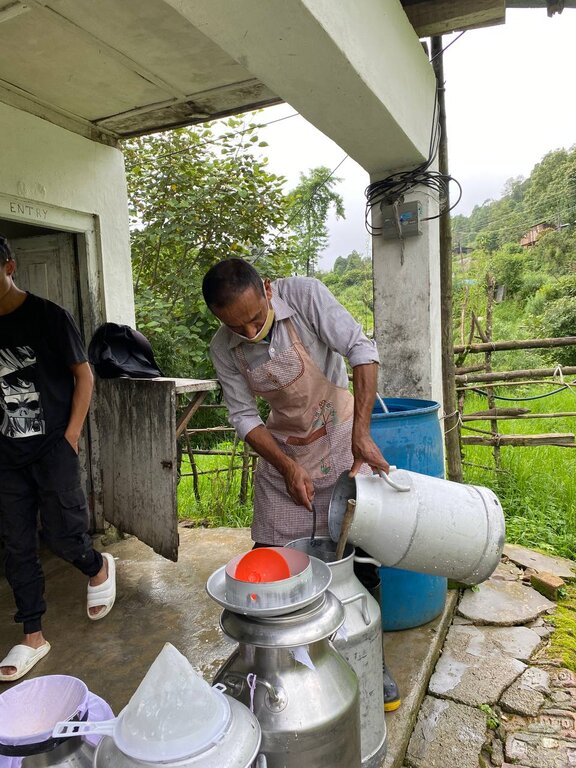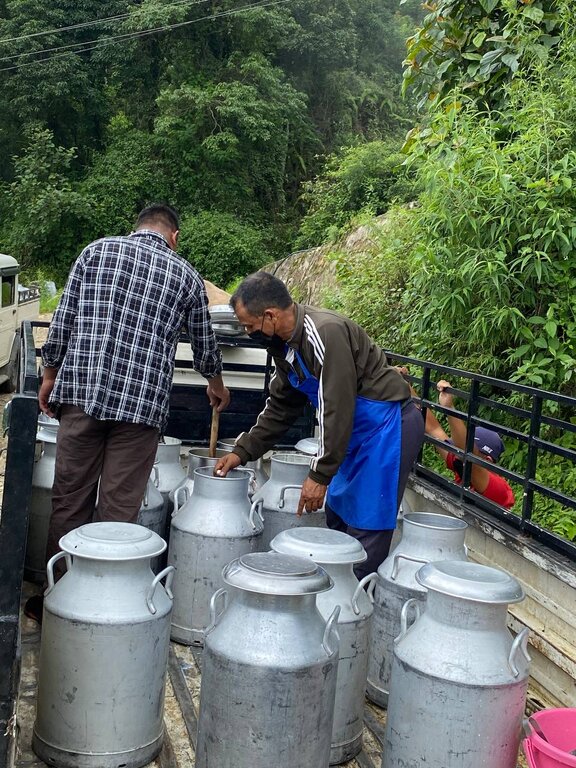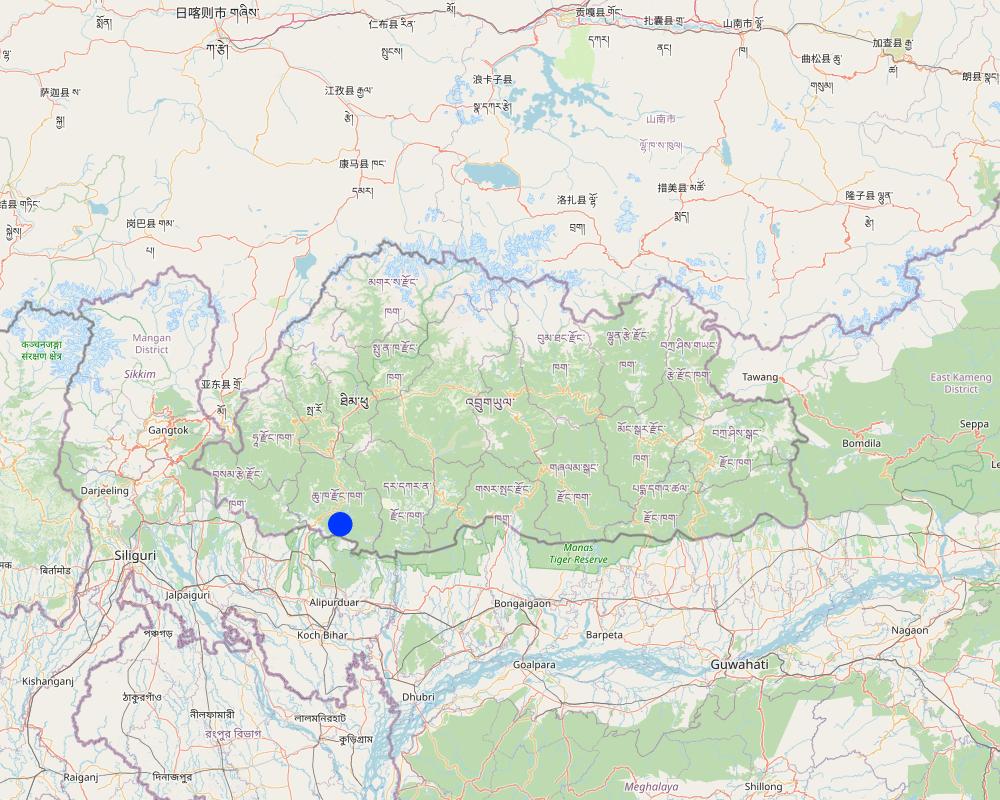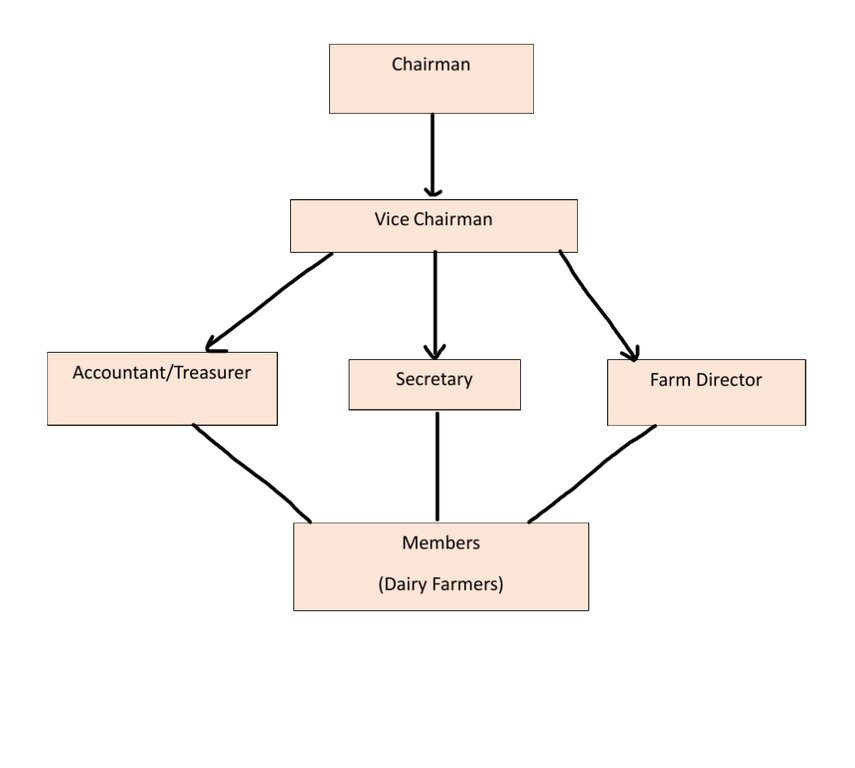Darla Dairy Cooperative [不丹]
- 创建:
- 更新:
- 编制者: Karma Wangdi
- 编辑者: chenga Tshering
- 审查者: William Critchley, Rima Mekdaschi Studer
Gonor Nyamley Detshen (སྒོ་ནོར་མཉམ་ལས་སྡེ་ཚན།)
approaches_6868 - 不丹
查看章节
全部展开 全部收起1. 一般信息
1.2 参与方法评估和文件编制的资源人员和机构的联系方式
关键资源人员
土地使用者:
Samal Bal Kumar
17720749
Darla, Chukha Dzongkhag (District)
不丹
土地使用者:
Gurung Pancha Maya
16931238
Darla Dairy Cooperative
Darla, Chukha Dzongkhag (District)
不丹
土地使用者:
Chettri Datta Singh
16911283
Darla Dairy Cooperative
Darla, Chukha Dzongkhag (District)
不丹
土地使用者:
Basnet Chandra Kumar
17810553
Darla Dairy Cooperative
Darla, Chukha Dzongkhag (District)
不丹
土地使用者:
Kharki Ram
17480128
Darla Dairy Cooperative
Darla, Chukha Dzongkhag (District)
不丹
有助于对方法进行记录/评估的项目名称(如相关)
Strengthening national-level institutional and professional capacities of country Parties towards enhanced UNCCD monitoring and reporting – GEF 7 EA Umbrella II (GEF 7 UNCCD Enabling Activities_Umbrella II)有助于对方法进行记录/评估的机构名称(如相关)
National Soil Services Centre, Department of Agriculture, Ministry of Agriculture & Livestock (NSSC) - 不丹1.3 关于使用通过WOCAT记录的数据的条件
(现场)数据是什么时候汇编的?:
17/07/2023
编制者和关键资源人员接受有关使用通过WOCAT记录数据的条件。:
是
2. SLM方法的描述
2.1 该方法的简要说明
The Darla dairy cooperative is an example of where farmers come together to form collective organizations for production, collection, transportation, processing, and marketing of milk and dairy products. These are business models operated as member-owned and member-controlled organizations.
2.2 该方法的详细说明
该方法的详细说明:
Livestock in Bhutan are reared for a multitude of purposes, encompassing the production of milk, food, and dung, as well as serving as a means of generating draught power, generating revenue, and accumulating assets. Dairy products, particularly butter and cheese, occupy significant significance within the Bhutanese nutritional framework and have emerged as a noteworthy economic resource for certain households in recent times. Knowing its importance many Bhutanese farmers are forming the cooperative groups. One thing that has been constantly growing over the years in Darla Gewog under Chhukha Dzongkhag is a Farmer’s Cooperative.
Darla dairy cooperatives are business owned and operated by dairy farmers, designed to collectively manage market milk and dairy products (Singh & Gupta, 2015). One of their main features is the collective ownership structure, where farmers become members and actively participate in decision-making processes. By pooling resources, dairy cooperatives enable farmers to access shared facilities, such as milk processing plants and storage, reducing individual cost and enhancing efficiency. Additionally, they offer fair and transparent pricing mechanisms, ensuring farmers receive a competitive price for their milk. Dairy cooperatives also provide valuable technical assistant, training, and access to markets, supporting farmer's growth and sustainability in the dairy industry (USDA, 2015).
The aims and objectives of dairy cooperatives revolve around empowering dairy farmers and promoting their collective welfare. One of the primary objectives is to facilitate shared ownership and democratic decision-making, allowing farmers to collectively manage their dairy operation. Another key aim is to ensure fair and equitable distribution of profits among members, promoting economic sustainability and social development within the dairy community. Dairy cooperatives also strive to provide access to modern technologies empowering farmers with the knowledge and skill needed for sustainable dairy farming practices (FAO, 2019).
The formation of a dairy cooperative typically involves several methods and steps to ensure successful establishment. Firstly, a core group of dairy farmers with common goals come together to initiate the cooperative. They conduct meetings, gauge interest, and identify potential members. Once the core group is established, they create formal bylaws that outline the cooperative's objectives, membership criteria, decision-making processes and profit-sharing mechanisms. To attract more members, awareness campaigns and informational sessions organized by gewog livestock extension agents showcase the benefits of joining the cooperatives. Financial planning and livestock management efforts are also undertaken to raise the necessary capital for initial investments, such as setting up milk processing facilities and infrastructures. There are 101 registered dairy farmers who contribute milk through the cooperative. The dairy cooperative is operated by 6 core members who manage the daily activities.
Dairy cooperatives play a crucial role in the dairy industry by bringing together various stakeholders and facilitating their collaboration. The primary stakeholders involved in dairy cooperative includes dairy farmers who are the core members and owner of the cooperative. They actively participate in decision-making and contribute their milk to the cooperative for processing and marketing. Additionally, consumers are significant stakeholders as they rely on dairy cooperatives to provide them with high quality milk and dairy product. Other stakeholders like the gewog livestock extension agent, the District livestock officer and other officials are involved in a meeting which is conducted twice a year. Marketing opportunities are the main driving forces for producers to produce more of any type of product. Identification of market opportunities and the development of proper marketing strategies for milk and milk products for selected groups of villages would be a useful approach to support dairy cooperatives.
2.3 该方法的照片
2.5 采用该方法的国家/地区/地点
国家:
不丹
区域/州/省:
Chukha
有关地点的进一步说明:
Darla
Map
×2.6 该方法的开始和终止日期
注明开始年份:
2014
若不知道准确的年份,请注明该方法的大致开始日期。:
不到10年前(最近)
2.7 方法的类型
- 最近的本地倡议/创新
2.8 该方法的主要目的/目标
The dairy cooperative aims to increase income through marketing of surplus milk, by engaging unemployed youths. Such intervention is expected to address problem srelated to rural urban migration.
2.9 推动或妨碍实施本办法所适用的技术的条件
财务资源和服务的可用性/可得性
- 启动
Priority support is given to the group and cooperatives in terms of investment and financial support by the government.
参与者的的协作/协调
- 启动
Dairy cooperative enables farmers' to access and shared facilities, by pooling resources
市场(购买投入,销售产品)和价格
- 启动
Increasing demand for milk and dairy products motivate farmers' to raise more dairy cattle and increase production
工作量、人力资源可用性
- 启动
Enabled sharing of workload equitabily
3. 相关利益相关者的参与和角色
3.1 该方法涉及的利益相关者及其职责
- 当地土地使用者/当地社区
Dairy farmers
Actively participate in decision-making and, produce and supply milk to the cooperative for processing and marketing as specified in the bylaw
- 地方政府
Livestock Extension Agent
Provide technical supports (health, feed and fodder, breeding and management) and monitor the progress of cooperative
- 国家政府(规划者、决策者)
District Livestock Officer
Royal audit authority
Assist in prioritization of issues and planning
Mobilize human and financial resources
Monitor and ensure adequate financial supports
3.2 当地土地使用者/当地社区参与该方法的不同阶段
| 当地土地使用者/当地社区的参与 | 指定参与人员并描述活动 | |
|---|---|---|
| 启动/动机 | 互动 | The core dairy farmers with guidance from the Gewog Livestock Extension Agent came up with ideas to establish a dairy cooperative/group. |
| 计划 | 互动 | Core members along with intellectual people from the village assisted by gewog livestock extension agent planned and proposed. |
| 实施 | 互动 | Interested dairy farmers supported by the gewog livestock agent and dzongkhag implemented the activity following the workplan and bylaws agreed upon. |
| 监测/评估 | 外部支持 | The activities of the dairy cooperatives are monitored periodically through field visit, monthly report, Bi-annual general assembly meeting and annual audit. |
3.3 流程图(如可用)
具体说明:
Presented flow chart of Darla Dairy cooperatives with engagement of all the members
作者:
Terms of Reference of Darla Dairy Cooperatives
3.4 有关SLM技术选择的决策
具体说明谁有权决定选择要实施的技术:
- 仅限土地使用者(自主)
解释:
The idea was conceptualized by the core group members, and accordingly planned and dairy cooperative was established initially. The engagement of other stakeholders came after the establishment.
明确做出决策的依据:
- 个人经验和意见(无记录)
4. 技术支持、能力建设和知识管理
4.1 能力建设/培训
是否为土地使用者/其他利益相关者提供培训?:
是
明确受训人员:
- 土地使用者
培训形式:
- 在职
涵盖的主题:
Group mobilization, bookkeeping , planning
Hygienic and clean milk production, collection, transportation, and processing.
Breeding and management (AI, Housing, feeding system)
注释:
The specialized training was provided by subject matter specialist, and on basic topic by the respective Extension Agent
4.2 咨询服务
土地使用者有权使用咨询服务吗?:
是
指明是否提供了咨询服务:
- 在土地使用者的土地上
说明/注释:
Officials from NCOA Yusipang monitored their work, and livestock officials organized awareness program on the management, care, prevention and control of common cattle diseases
4.3 机构强化(组织发展)
是否通过这种方法建立或加强了机构?:
- 是,适度
具体说明机构的强化或建立程度:
- 本地
说明机构、角色和职责、成员等。:
The number of dairy cooperative members have increased by 15 households.
具体说明支持类型:
- 设备
提供进一步细节:
All members of the cooperative were supplied with milk cans to collect, store and transport milk
4.4 监测和评估
监测和评估是该方法的一部分吗?:
是
注释:
Physical on site monitoring and evaluating the quality, standard, cleanliness of the work and products
若是,该文件是否用于监测和评估?:
否
4.5 研究
研究是该方法的一部分吗?
否
5. 融资和外部物质支持
5.1 该方法中SLM组成部分的年度预算
如果不知道准确的年度预算,请给出一个范围:
- 10,000-100,000
注释(例如主要的资助来源/主要捐助者):
The approach was implemented with the seed money collected from the members.
5.2 为土地使用者提供财政/物质支援
土地使用者是否获得实施该技术的财政/物质支持?:
是
如果是,请具体说明支持的类型、条件和提供者:
They were provided with the milk processing equipment
5.3 对特定投入的补贴(包括劳动力)
- 农业
| 具体说明哪些投入得到了补贴 | 程度如何 | 对补贴做出具体说明 |
|---|---|---|
| Machines | 充分融资 | -Chunning machine -Office furnitures - cream separator -analyzer -yogurt incubator -deep freezer and fridge |
注释:
The government fully funded construction of milk processing, and is being operated by the cooperative free of cost.
5.4 信用
是否根据SLM活动的方法给予信用值?:
否
5.5 其它激励或手段
是否有其他激励措施或工具用于促进SLM技术的实施?:
否
6. 影响分析和结论性陈述
6.1 方法的影响
该方法是否有助于当地土地使用者,提高利益相关者的参与度?:
- 否
- 是,很少
- 是,中等
- 是,支持力度很大
They got more recognition and support
这种方法是否有助于基于证据的决策?:
- 否
- 是,很少
- 是,中等
- 是,支持力度很大
future plans are drawn based on the needs, issues and challages faced during the operation of dairy cooperative
该方法是否建立/加强了机构、利益相关者之间的合作?:
- 否
- 是,很少
- 是,中等
- 是,支持力度很大
Physical and financial support received have enhanced, improved social cohesion
该方法是否改善了性别平等并赋予女性权力?:
- 否
- 是,很少
- 是,中等
- 是,支持力度很大
Every men and women is given equal right.
该方法是否改善了粮食安全/改善了营养?:
- 否
- 是,很少
- 是,中等
- 是,支持力度很大
Increased milk and dairy products and excess dairy products are processed and supplied to schools, hospitals and other markets.
该方法是否改善了市场准入?:
- 否
- 是,很少
- 是,中等
- 是,支持力度很大
Formalized group marketing, and the quality of milk products have improved
该方法是否会带来就业、收入机会?:
- 否
- 是,很少
- 是,中等
- 是,支持力度很大
Some school drop-outs and laid-off youths are employed in collecting and transportation of milk.
6.2 土地使用者实施SLM的主要动机
- 增加利润(能力),提高成本效益比
Member earn an average gross monthly income between Nu. 30000-40000
- 支付/补贴
Government provide subsidies (materials support) for the construction of improved dairy shed
- 加入运动/项目/团体/网络
Their products are marketed within the gewog, and excess products are marketed to other districts
6.3 方法活动的可持续性
土地使用者能否维持通过该方法实施的措施(无外部支持的情况下)?:
- 是
若是,请说明如何维持:
The initial investment has been recovered, and current income meets the operation cost.
6.4 该方法的长处/优点
| 土地使用者眼中的长处/优势/机会 |
|---|
| Source of cash income |
| Increased cooperation and network |
| improve household livelihood |
| 编制者或其他关键资源人员认为的长处/优势/机会 |
|---|
| Creates employment opportunities to the school drop-outs and rural youths |
| Contributes to food security and better nutrition |
6.5 该方法的弱点/缺点以及克服它们的方法
| 土地使用者认为的弱点/缺点/风险 | 如何克服它们? |
|---|---|
| Scattered settlement and production | Increase the number of transportation vehicles, improve road connectivity |
| Short shelf life of milk | Try marketing in nearby places if possible, install cold chain facilities |
| Delay in payment | Create a terms of agreement with the retailers to ensure payment on time |
| 编制者或其他关键资源人员认为的弱点/缺点/风险 | 如何克服它们? |
|---|---|
| No proper market outlet for wholesale marketing | explore market outside gewog |
7. 参考和链接
7.1 方法/信息来源
- 实地考察、实地调查
5
- 与土地使用者的访谈
5
7.3 链接到网络上可用的相关信息
标题/说明:
Cooperatives in the Dairy Industry
URL:
https://www.google.com/url?sa=t&source=web&rct=j&opi=89978449&url=https://www.rd.usda.gov/files/cir1-16.pdf&ved=2ahUKEwi9z4b8-Z6AAxV7umMGHQsgBZUQFnoECBMQAQ&usg=AOvVaw0jmrAUETNEh8crEba04qjj
标题/说明:
Dairy development through cooperative structure
URL:
https://www.fao.org/3/T3080T/t3080T0a.htm
标题/说明:
Analysis of knowledge and adoption level of the dairy farmers regarding clean milk production (CMP) practices
URL:
https://www.indianjournals.com/ijor.aspx?target=ijor:jdfhs&volume=34&issue=3&article=002
链接和模块
全部展开 全部收起链接
无链接
模块
无模块


